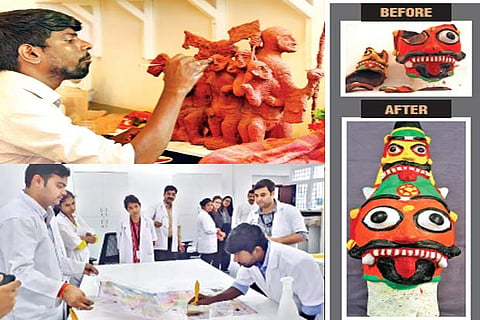

Chennai
After being trained by Tody Cezar, a well-acclaimed senior conservationist from Portugal, L Amirthanathan has been working as an assistant conservator at the conservation lab in DakshinaChitra heritage museum. Under his guidance, the museum authorities havecollected, preserved, exhibited and interpreted several objects of historical significance.
Now, the conservation lab is extending its service to the public and recently, he restored a 150-year-old Bible belonging to a private collector. In an interview with DT Next, he talks about the need to preserve artefacts from deterioration and how artefacts can help in creating awareness about history.“The interest in preserving heritage objects and heirlooms have increased over the past few years. Over time, objects begin to deteriorate for a variety of reasons such as environmental conditions, use and natural decay. In order to maintain the objects in good condition, proper care and maintenance are necessary. Be it old photographs, artefacts, sculptures, manuscripts, etc, people are finding ways to restore them. But what’s more important is that artefact enthusiasts should understand the right way of protecting the objects,” says Amirthanathan.
So far, he has only preserved, conserved and restored artefacts, including wood, metal, stone, prints, paintings, terracotta, etc, that are related to local and ethnic history that are owned by the DakshinaChitra heritage museum. When he came to know that the lab will be extending its service to the public, Amirthanathan couldn’t contain his excitement. “This is a great opportunity for me to explore and learn more about the process of preservation. Since the lab started restoring objects from the public, we have refurbished a Holy Bible, bronze box, terracotta dolls, ivory jewel box, paintings and some old photographs,” he tells DT Next.
The conservator also holds training for interns on conservation techniques and hosts exhibitions to create awareness on the importance of conservation. Sharing with us the process behind conservation, Amirthanathan says, “Depending on the client’s necessity, we repair and restore artefacts for posterity. Most prefer to maintain the original look of the objects. We don’t use any chemicals for restoration. When we receive an artefact or a painting or a photograph, first we learn the basics like the type of materials used for making it. After discussing with the client, we finalise the restoration technique.”
Amirthanathan points out that the process is not an easy one. “We need a lot of patience to do this. Sometimes, we can finish the work in a few days. But some will take a couple of month’s time. Also, the person who is restoring an object should be knowledgeable in history and heritage,” he remarks.
Visit news.dtnext.in to explore our interactive epaper!
Download the DT Next app for more exciting features!
Click here for iOS
Click here for Android